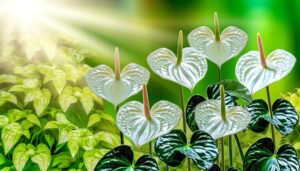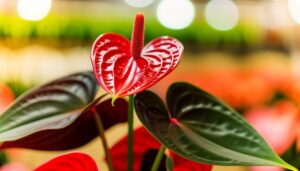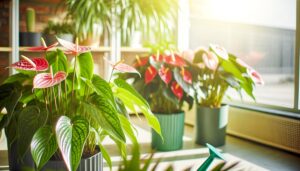Why Are My Anthurium Leaf Tips Turning Red? Key Causes!
Red tips on your Anthurium leaves usually signal stress responses from specific factors. Improper watering, whether overwatering or underwatering, disrupts nutrient uptake and hydration, causing discoloration.
Nutrient imbalances, particularly deficiencies in phosphorus, potassium, and iron, directly influence leaf health and color. Environmental conditions like direct sunlight, erratic temperatures, and insufficient humidity can exacerbate stress, leading to red-tipped leaves.
In addition, pests such as spider mites and aphids may cause damage, manifesting as red leaf tips. Addressing these issues involves careful adjustment of watering, nutrient supplementation, light exposure, and pest management.
Understanding these nuances can enhance your plant’s health and prevent red leaf tips.

Key Takeaways
- Overwatering or underwatering can stress the plant, leading to red leaf tips.
- Nutrient deficiencies, particularly phosphorus and potassium, can cause red discoloration on leaf tips.
- Direct sunlight exposure can burn the leaves, resulting in red-tipped leaves.
- Sudden temperature fluctuations can stress the plant, causing red leaf tips.
- Pest infestations, such as spider mites or aphids, can damage leaves and result in red tips.
Watering Issues
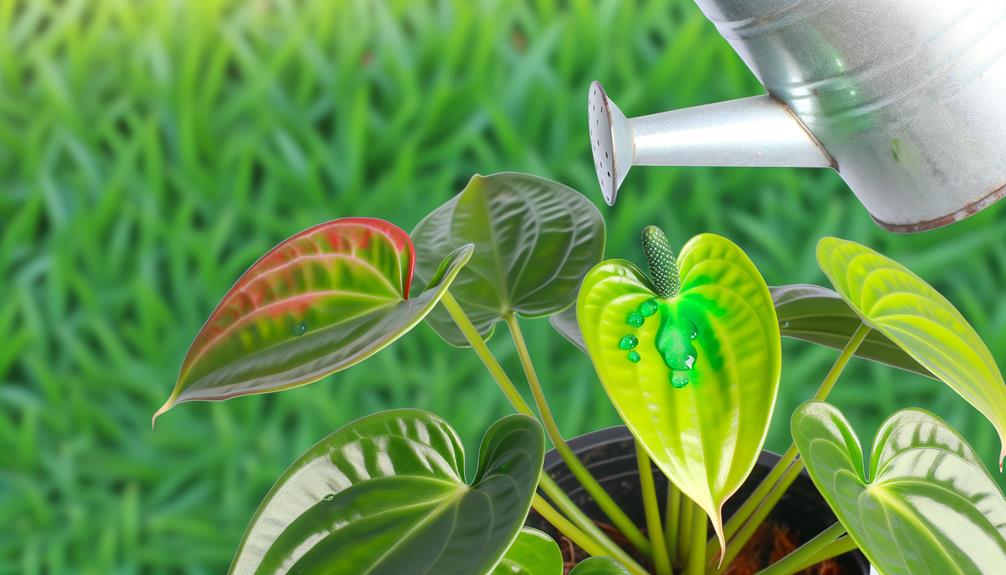
One of the primary causes of Anthurium leaf tips turning red is improper watering, which can manifest as either overwatering or underwatering. You need to make sure the soil is consistently moist but not waterlogged.
Overwatering can lead to root rot, which impairs the plant’s ability to uptake essential nutrients, causing the leaf tips to redden.
Conversely, underwatering stresses the plant, leading to dehydration and red leaf tips as a sign of physiological distress. Utilize a well-draining potting mix and check that your pot has adequate drainage holes.
Additionally, regularly assess soil moisture levels using a moisture meter or by inserting your finger about an inch deep into the soil.
Balancing hydration levels is vital for maintaining Anthurium health and preventing red leaf tips.
Nutrient Deficiencies
Nutrient deficiencies can greatly impact anthurium leaf coloration, particularly at the tips.
A deficiency in phosphorus disrupts energy transfer and metabolic processes, while insufficient potassium affects water regulation and enzyme activation.
Iron deficiency, on the other hand, impairs chlorophyll synthesis, leading to chlorosis and red leaf tips.
Phosphorus Deficiency
Phosphorus insufficiency, often appearing as red discoloration at the tips of Anthurium leaves, hampers ATP synthesis and energy transfer, crucial for proper plant growth and development.
This nutrient is vital in various physiological functions, including photosynthesis and nutrient translocation. When your Anthurium lacks phosphorus, cellular processes falter, resulting in stunted growth and compromised structural integrity.
You’ll notice older leaves showing symptoms first, as phosphorus is a mobile nutrient. To rectify this, make sure your soil has a balanced pH, as phosphorus availability decreases in highly acidic or alkaline conditions.
Incorporate a phosphorus-rich fertilizer, preferably one with a high middle number in its N-P-K ratio, to address the insufficiency. Regular monitoring and adjustments will maintain your Anthurium’s health and vibrancy.
Potassium Levels
In addition to phosphorus, potassium deficiency can also cause red discoloration at the tips of Anthurium leaves. This nutrient plays a pivotal role in osmoregulation, enzyme activation, and photosynthesis.
Without sufficient potassium, your plant’s stomatal function is compromised, leading to inefficient water usage and stress responses. You’ll notice the red tips as an early indicator, signaling the plant’s struggle to maintain cellular balance.
Potassium is essential for activating over 60 enzymatic processes that drive metabolic functions and energy transference. When potassium is lacking, chlorophyll production diminishes, affecting photosynthetic efficiency and overall plant vigor.
Make sure your Anthurium receives a balanced fertilizer rich in potassium to prevent these symptoms and promote robust growth.
Iron Deficiency
Iron deficiency can manifest in Anthurium leaves as interveinal chlorosis, where the tissue between veins turns yellow while the veins themselves remain green.
This nutrient imbalance often arises from high soil pH, which limits iron availability. You might notice stunted growth and poor leaf development as well.
Addressing iron deficiency involves adjusting the soil pH to a more acidic level and incorporating chelated iron supplements.
| Symptom | Cause | Solution |
|---|---|---|
| Interveinal chlorosis | High soil pH | Lower soil pH |
| Yellow leaf tissue | Iron unavailability | Add chelated iron |
| Stunted growth | Nutrient imbalance | Balance nutrient levels |
| Poor leaf development | Iron deficiency | Use iron-rich fertilizers |
| Green veins | Specific to iron | Monitor soil conditions |
Ensure you regularly test soil pH and nutrient levels for the best plant health.
Light Exposure
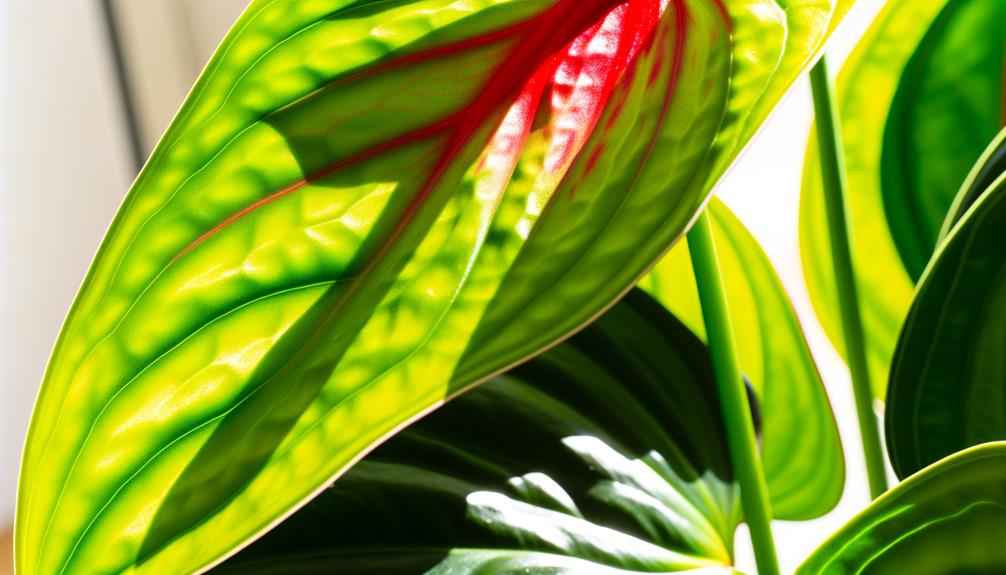
Adequate light exposure is crucial for Anthurium health, as insufficient or excessive light can cause stress, leading to red discoloration at the leaf tips. Anthuriums thrive in bright, indirect light, mirroring their natural understory habitat.
Direct sunlight can cause photodamage, showing as red-tipped leaves due to chlorophyll breakdown and anthocyanin accumulation.
Conversely, low light conditions impede photosynthesis, weakening the plant and making it susceptible to similar discoloration.
You should aim to place your Anthurium near an east or north-facing window, ensuring filtered light exposure. If natural light is inadequate, consider using grow lights to maintain optimal light levels.
Monitoring and adjusting light conditions are critical steps to prevent stress-induced pigmentation changes and guarantee robust Anthurium growth.
Temperature Fluctuations
Temperature fluctuations can greatly impact Anthurium health, causing red leaf tips due to thermal stress and impaired physiological processes. Your Anthurium prefers stable temperatures between 70-85°F (21-29°C).
Sudden drops or spikes, especially below 60°F (16°C) or above 90°F (32°C), disrupt cellular function, leading to oxidative stress and anthocyanin accumulation, which manifests as red tips.
Maintaining an even temperature is essential; avoid drafts from windows, doors, or air conditioning vents.
Rapid temperature changes hinder nutrient uptake and water absorption, exacerbating stress responses. Monitor your Anthurium’s environment closely. Use a digital thermometer to guarantee consistency.
Humidity Levels
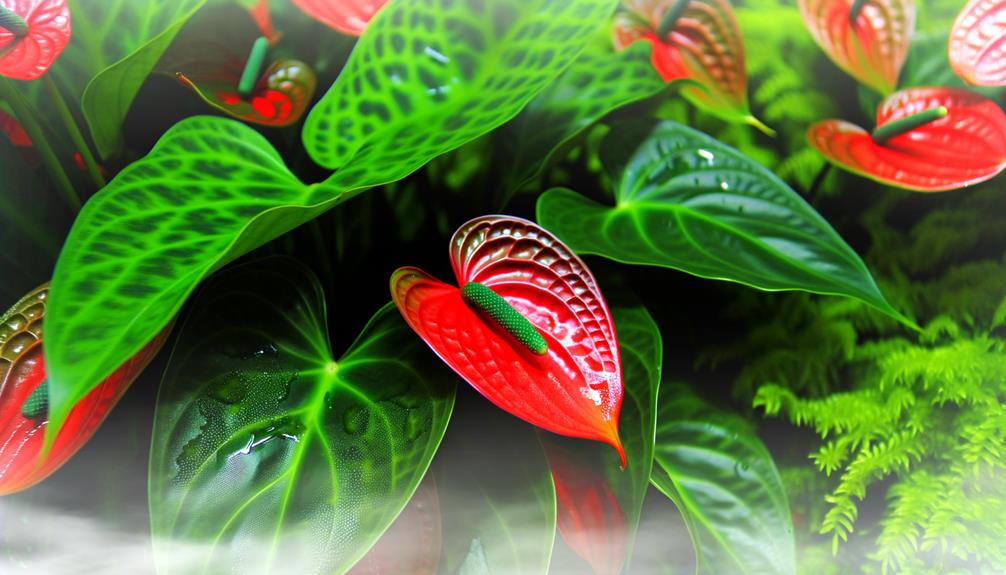
Maintaining ideal humidity levels is essential for Anthurium health, ideally between 70% and 80%.
If the air is too dry, you can employ methods like using a humidifier or placing a water tray near the plant to increase humidity.
Monitoring and adjusting these levels will prevent the leaf tips from turning red due to stress.
Optimal Humidity Range
Anthuriums thrive most in environments where the ambient moisture levels are maintained between 60% and 80%, ensuring ideal physiological processes.
High moisture facilitates stomatal function, enhancing gas exchange and transpiration. This microenvironment prevents desiccation of leaf tissues, thereby reducing the risk of red leaf tips, which often signal stress or suboptimal conditions.
You should monitor moisture using a hygrometer to maintain consistency. Deviations from this ideal range can impair nutrient uptake and cellular respiration, leading to visible physiological distress.
Moreover, such conditions help in maintaining turgor pressure, optimal for the plant’s structural integrity. Ensuring appropriate moisture levels isn’t just a suggestion; it’s a vital factor in Anthurium care that directly impacts their health and vibrancy.
Increasing Humidity Methods
To enhance humidity levels for your Anthuriums, you can employ several effective methods such as using a humidifier, placing the plants on a pebble tray, or grouping them with other moisture-loving plants.
A humidifier guarantees consistent humidity by releasing water vapor into the air.
Pebble trays, filled with water, create localized humidity as the water evaporates.
Grouping plants together creates a microenvironment where transpiration from the leaves increases ambient moisture.
For precise humidity management, monitor levels using a hygrometer, aiming for 60-80% relative humidity.
Avoid misting, as it can promote fungal infections.
Implementing these techniques can prevent red leaf tips, ensuring your Anthuriums maintain peak physiological conditions for robust growth and vibrant foliage.
Pest Infestations
Red leaf tips on anthuriums can often signal pest infestations such as spider mites or aphids, which feed on the plant’s sap and cause cellular damage. These pests weaken your anthurium by puncturing cell walls, leading to chlorosis and necrosis.
Perform a thorough inspection of the leaves, especially the undersides, for tiny specks or webbing. You’ll want to use a magnifying glass to detect these minuscule invaders. If infestation is confirmed, employ an integrated pest management strategy. Neem oil, insecticidal soap, or systemic insecticides can be effective.
Make sure you isolate the affected plant to prevent cross-contamination. Regularly monitor your anthurium, maintaining ideal humidity and airflow to deter future pest colonization.
Conclusion
Essentially, your anthurium’s red leaf tips might be a cry for help, reminiscent of a canary in a coal mine signaling underlying issues.
Addressing watering schedules, nutrient intake, light exposure, temperature stability, humidity levels, and potential pests will restore its essential health.
By channeling Sherlock Holmes‘ meticulous attention to detail, you can diagnose and remedy these factors, ensuring your plant thrives as a lush masterpiece in your botanical collection.

